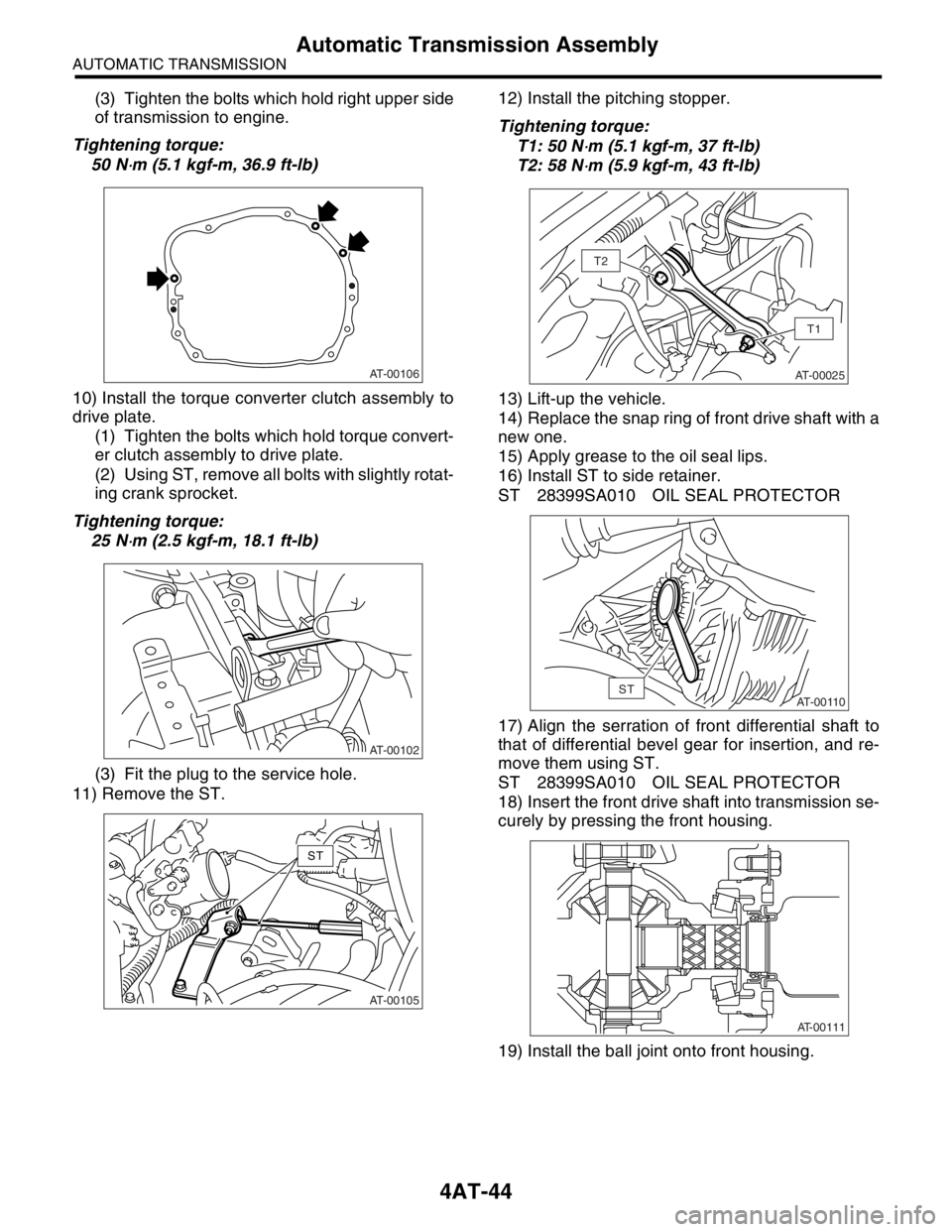2004 SUBARU FORESTER engine oil
[x] Cancel search: engine oilPage 2356 of 2870

4AT-44
AUTOMATIC TRANSMISSION
Automatic Transmission Assembly
(3) Tighten the bolts which hold right upper side
of transmission to engine.
Tightening torque:
50 N
⋅m (5.1 kgf-m, 36.9 ft-lb)
10) Install the torque converter clutch assembly to
drive plate.
(1) Tighten the bolts which hold torque convert-
er clutch assembly to drive plate.
(2) Using ST, remove all bolts with slightly rotat-
ing crank sprocket.
Tightening torque:
25 N
⋅m (2.5 kgf-m, 18.1 ft-lb)
(3) Fit the plug to the service hole.
11) Remove the ST.12) Install the pitching stopper.
Tightening torque:
T1: 50 N
⋅m (5.1 kgf-m, 37 ft-lb)
T2: 58 N
⋅m (5.9 kgf-m, 43 ft-lb)
13) Lift-up the vehicle.
14) Replace the snap ring of front drive shaft with a
new one.
15) Apply grease to the oil seal lips.
16) Install ST to side retainer.
ST 28399SA010 OIL SEAL PROTECTOR
17) Align the serration of front differential shaft to
that of differential bevel gear for insertion, and re-
move them using ST.
ST 28399SA010 OIL SEAL PROTECTOR
18) Insert the front drive shaft into transmission se-
curely by pressing the front housing.
19) Install the ball joint onto front housing.
AT-00106
AT-00102
AT-00105
ST
AT-00025
T1
T2
AT-00110ST
AT-00111
Page 2472 of 2870

4AT(H4SO)-13
AUTOMATIC TRANSMISSION (DIAGNOSTIC)
Transmission Control Module (TCM) I/O Signal
Inhibitor
switch“2” range
switchB55 6Select lever in “2” range Less than 1
—
Select lever in any other
than “2” rangeMore than 8
“1” range
switchB55 7Select lever in “1” range Less than 1
—
Select lever in any other
than “1” rangeMore than 8
Brake switch B55 12Brake pedal depressed More than 10.5
—
Brake pedal released Less than 1
Kick-down switch B55 11Throttle fully opened Less than 1
—
Throttle fully closed More than 6.5
AT OIL TEMP warning light B56 10Light ON Less than 1
—
Light OFF More than 9
Throttle position sensor B54 3Throttle fully closed 0.2 — 1.0
—
Throttle fully open 4.2 — 4.7
Throttle position sensor
power supplyB54 2Ignition switch ON (with
engine OFF)4.8 — 5.3 —
ATF temperature sensor B54 11ATF temperature 20°C
(68°F)1.6 — 2.0 2.1 k — 2.9 k
ATF temperature 80°C
(176°F)0.4 — 0.9 275 — 375
Rear vehicle speed sensor B55 24Vehicle stopped 0
450 — 650
Vehicle speed at least 20
km/h (12 MPH)More than 1 (AC range)
Front vehicle speed sensor B55 18Vehicle stopped 0
450 — 650
Vehicle speed at least 20
km/h (12 MPH)More than 1 (AC range)
Torque converter turbine
speed sensorB55 8Engine idling after warm-
up (D range)0
450 — 650
Engine idling after warm-
up (N range)More than 1 (AC range)
Vehicle speed output signal B56 17Vehicle speed at most 10
km/h (6 MPH)Less than 1 ←
→ More than 4—
Engine speed signal B55 17Ignition switch ON (with
engine OFF)More than 10.5
—
Ignition switch ON (with
engine ON)8 — 11
Cruise set signal B55 22When cruise control is set
(SET lamp ON)Less than 1
—
When cruise control is not
set (SET lamp OFF)More than 6.5
Torque control signal 1 B56 5Ignition switch ON (with
engine ON)More than 4 —
Torque control signal 2 B56 14Ignition switch ON (with
engine ON)More than 4 —
Torque control cut signal B55 10Ignition switch ON
(After engine is warmed-up)8—
Intake manifold pressure
signalB54 1 Engine idling after warm-up 0.4 — 1.6 —
Shift solenoid 1 B54 221st or 4th gear More than 9
10 — 16
2nd or 3rd gear Less than 1
Shift solenoid 2 B54 51st or 2nd gear More than 9
10 — 16
3rd or 4th gear Less than 1 Check with ignition switch ON.
ContentConnector
No.Terminal No. Measuring conditions Voltage (V)Resistance
to chassis
ground (Ω)
Page 2475 of 2870

4AT(H4SO)-16
AUTOMATIC TRANSMISSION (DIAGNOSTIC)
Transmission Control Module (TCM) I/O Signal
(1) Transmission control module
(TCM)(17) “P” range indicator light (35) Torque control signal 2
(18) “P” range switch (36) Torque control signal 1
(2) Cruise control module (19) “R” range indicator light (37) Intake manifold pressure signal
(3) ABS control module (20) “R” range switch (38) AT diagnostics signal
(4) Ignition switch (21) “N” range indicator light (39) Engine control module (ECM)
(5) Brake switch (22) “N” range switch (40) ATF temperature sensor
(6) Brake light (23) “D” range indicator light (41) Torque converter turbine speed
sensor
(7) Battery (24) “D” range switch
(8) Combination meter (Speedome-
ter circuit)(25) “3” range indicator light (42) Rear vehicle speed sensor
(26) “3” range switch (43) Front vehicle speed sensor
(9) AT OIL TEMP warning light (27) “2” range indicator light (44) Shift solenoid 1
(10) FWD indicator light (28) “2” range switch (45) Shift solenoid 2
(11) POWER indicator light (29) “1” range indicator light (46) 2-4 brake timing solenoid
(12) FWD switch (30) “1” range switch (47) Line pressure duty solenoid
(13) POWER switch (31) Data link connector (48) 2-4 brake duty solenoid
(14) Kick-down switch (32) Throttle position sensor (49) Lock-up duty solenoid
(15) Hold indicator light (33) Engine speed signal (50) Low clutch timing solenoid
(16) HOLD switch (34) Torque control cut signal (51) Transfer duty solenoid
Page 2512 of 2870

4AT(H4SO)-53
AUTOMATIC TRANSMISSION (DIAGNOSTIC)
Diagnostic Procedure with Diagnostic Trouble Code (DTC)
3 CHECK OUTPUT SIGNAL EMITTED FROM
TCM.
1) Connect the connectors to TCM and ECM.
2) Turn the ignition switch to ON (engine OFF).
3) Measure the voltage between TCM con-
nector terminals.
Connector & terminal
(B56) No. 14 (+) — Chassis ground (
−):
(B56) No. 5 (+) — Chassis ground (
−):Is the voltage more than 4.8 V? Even if the
POWER indicator
light was blinking,
the circuit has
returned to a nor-
mal condition at
this time. A tempo-
rary poor contact
of the connector or
harness may be
the cause. Repair
the harness or
connector in TCM
and ECM.Go to step 4.
4 CHECK POOR CONTACT.Is there poor contact in torque
control signal circuit?Repair the poor
contact.Go to step 5.
5 CHECK GROUND LINE BETWEEN TRANS-
MISSION AND BODY.
Check installing condition of the ground line in
transmission and body.Is there any dirt or rust at the
ground line installing point?Remove dirt and
rust.Go to step 6.
6 CHECK GROUND LINE BETWEEN TRANS-
MISSION AND BODY.
Check installing condition of the ground line in
transmission and body.Is the tightening torque value
13 N⋅m (1.3 kgf-m, 9.4 ft-lb)?Go to step 7.Tighten to the
specified torque.
7 CHECK GROUND LINE INSIDE TRANSMIS-
SION.
1) Drain the ATF and remove oil pan.
2) Check the tightening torque value of ground
line installing bolt.Is the tightening torque value 8
N⋅m (0.8 kgf-m, 5.8 ft-lb)?Go to step 8.Tighten to the
specified torque.
8 CHECK GROUND CIRCUIT OF ECM.
with Diagnostic Trouble Code (DTC).>Is there any trouble? Repair the ground
terminal and/or
ground circuit of
ECM.Go to step 9.
9 RECHECK OUTPUT SIGNAL EMITTED
FROM TCM.
Measure the voltage between TCM connector
and chassis ground.
Connector & terminal
(B56) No. 14 (+) — Chassis ground (
−):
(B56) No. 5 (+) — Chassis ground (
−):Is the voltage more than 4 V? Replace the TCM.
trol Module
(TCM).>Replace the ECM. Step Check Yes No
Page 2516 of 2870

4AT(H4SO)-57
AUTOMATIC TRANSMISSION (DIAGNOSTIC)
Diagnostic Procedure with Diagnostic Trouble Code (DTC)
2 CHECK HARNESS CONNECTOR BETWEEN
TCM AND TRANSMISSION.
Measure the resistance of harness between
TCM connector and chassis ground.
Connector & terminal
(B54) No. 22 — Chassis ground:Is the resistance more than 1
MΩ?Go to step 3.Repair the short
circuit in harness
between TCM and
transmission con-
nector.
3 CHECK SHIFT SOLENOID 1.
Measure the resistance between transmission
connector terminals.
Connector & terminal
(T4) No. 1 — No. 16:Is the resistance 10 — 16 Ω? Go to step 4.Go to step 7.
4 CHECK OUTPUT SIGNAL EMITTED FROM
TCM.
1) Connect the connectors to TCM and trans-
mission.
2) Turn the ignition switch to ON (engine
OFF).
3) Move the select lever to “D” range.
4) Measure the voltage between TCM con-
nector and chassis ground.
Connector & terminal
(B54) No. 22 (+) — Chassis ground (
−):Is the voltage more than 9 V? Go to step 5.Go to step 6.
5 CHECK OUTPUT SIGNAL EMITTED FROM
TCM.
1) Turn the HOLD mode switch to ON.
2) Measure the voltage between TCM con-
nector and chassis ground.
Connector & terminal
(B54) No. 22 (+) — Chassis ground (
−):Is the voltage less than 1 V? Even if the
POWER indicator
light was blinking,
the circuit has
returned to a nor-
mal condition at
this time. A tempo-
rary poor contact
of the connector or
harness may be
the cause. Repair
the harness or
contact in TCM.Go to step 6.
6 CHECK POOR CONTACT.Is there poor contact in shift
solenoid 1 circuit?Repair poor con-
tact.Replace the TCM.
trol Module
(TCM).>
7 CHECK SHIFT SOLENOID 1 (IN TRANSMIS-
SION).
1) Remove the transmission connector from
bracket.
2) Lift-up or raise the vehicle and support with
rigid rack.
NOTE:
Raise all wheels off ground.
3) Drain the ATF.
CAUTION:
Do not drain the ATF until it cools down.
4) Remove the oil pan, and disconnect con-
nector from shift solenoid 1.
5) Measure the resistance between shift sole-
noid 1 connector and transmission ground.
Te r m i n a l s
No. 1 — Transmission ground:Is the resistance 10 — 16 Ω? Go to step 8.Replace the shift
solenoid 1.
Solenoids, Duty
Solenoids and ATF
Temperature Sen-
sor.> Step Check Yes No
Page 2529 of 2870

4AT(H4SO)-70
AUTOMATIC TRANSMISSION (DIAGNOSTIC)
Diagnostic Procedure with Diagnostic Trouble Code (DTC)
8 CHECK OUTPUT SIGNAL EMITTED FROM
TCM USING SUBARU SELECT MONITOR.
1) Turn the ignition switch to ON (engine
OFF).
2) Throttle is fully open.
3) Read the data of line pressure duty sole-
noid using Subaru Select Monitor.Is the value less than 25%? Even if the
POWER indicator
light was blinking,
the circuit has
returned to a nor-
mal condition at
this time. A tempo-
rary poor contact
of the connector or
harness may be
the cause. Repair
the harness or
connector in trans-
mission.Go to step 9.
9 CHECK POOR CONTACT.Is there poor contact in line
pressure duty solenoid circuit?Repair the poor
contact.Replace the TCM.
trol Module
(TCM).>
10 CHECK LINE PRESSURE DUTY SOLENOID
(IN TRANSMISSION).
1) Remove the transmission connector from
bracket.
2) Drain the ATF.
CAUTION:
Do not drain the ATF until it cools down.
3) Remove the oil pan, and disconnect con-
nector from line pressure duty solenoid.
4) Measure the resistance between line pres-
sure duty solenoid connector and transmission
ground.
Te r m i n a l s
No. 1 — Transmission ground:Is the resistance 2.0 — 4.5 Ω? Go to step 11.Replace the line
pressure duty
solenoid.
noids, Duty Sole-
noids and ATF
Temperature Sen-
sor.>
11 CHECK HARNESS CONNECTOR BETWEEN
TRANSMISSION AND LINE PRESSURE
DUTY SOLENOID.
Measure the resistance of harness between
line pressure duty solenoid and transmission
connector.
Connector & terminal
(T4) No. 5 — (AT2) No. 1:Is the resistance less than 1
Ω?Go to step 12.Repair the open
circuit in harness
between line pres-
sure duty solenoid
and transmission
connector.
12 CHECK HARNESS CONNECTOR BETWEEN
TRANSMISSION AND LINE PRESSURE
DUTY SOLENOID.
Measure the resistance of harness between
transmission connector and transmission
ground.
Connector & terminal
(T4) No. 5 — Transmission ground:Is the resistance more than 1
MΩ?Even if the
POWER indicator
light was blinking,
the circuit has
returned to a nor-
mal condition at
this time. A tempo-
rary poor contact
of the connector or
harness may be
the cause. Repair
the harness or
connector in line
pressure duty
solenoid and
transmission.Repair the short
circuit in harness
between line pres-
sure duty solenoid
and transmission
connector. Step Check Yes No
Page 2532 of 2870

4AT(H4SO)-73
AUTOMATIC TRANSMISSION (DIAGNOSTIC)
Diagnostic Procedure with Diagnostic Trouble Code (DTC)
8 CHECK OUTPUT SIGNAL EMITTED FROM
TCM USING SUBARU SELECT MONITOR.
1) Turn the ignition switch to ON (engine
OFF).
2) Throttle is fully open.
3) Read the data of 2-4 brake duty solenoid
using Subaru Select Monitor.Is the value less than 25%? Even if the
POWER indicator
light was blinking,
the circuit has
returned to a nor-
mal condition at
this time. A tempo-
rary poor contact
of the connector or
harness may be
the cause. Repair
the harness or
connector in TCM
and transmission.Go to step 9.
9 CHECK POOR CONTACT.Is there poor contact in 2-4
brake duty solenoid circuit?Repair the poor
contact.Replace the TCM.
trol Module
(TCM).>
10 CHECK 2-4 BRAKE DUTY SOLENOID (IN
TRANSMISSION).
1) Remove the transmission connector from
bracket.
2) Drain the ATF.
CAUTION:
Do not drain the ATF until it cools down.
3) Remove the oil pan, and disconnect con-
nector from 2-4 brake duty solenoid.
4) Measure the resistance between 2-4 brake
duty solenoid connector and transmission
ground.
Te r m i n a l s
No. 1 — Transmission ground:Is the resistance 2.0 — 4.5 Ω? Go to step 11.Replace the 2-4
brake duty sole-
noid.
noids, Duty Sole-
noids and ATF
Temperature Sen-
sor.>
11 CHECK HARNESS CONNECTOR BETWEEN
TRANSMISSION AND 2-4 BRAKE DUTY SO-
LENOID.
Measure the resistance of harness between 2-
4 brake duty solenoid and transmission con-
nector.
Connector & terminal
(T4) No. 9 — (AT7) No. 1:Is the resistance less than 1
Ω?Go to step 12.Repair the open
circuit in harness
between 2-4 brake
duty solenoid and
transmission con-
nector.
12 CHECK HARNESS CONNECTOR BETWEEN
TRANSMISSION AND 2-4 BRAKE DUTY SO-
LENOID.
Measure the resistance of harness between
transmission connector and transmission
ground.
Connector & terminal
(T4) No. 9 — Transmission ground:Is the resistance more than 1
MΩ?Even if the
POWER indicator
light was blinking,
the circuit has
returned to a nor-
mal condition at
this time. A tempo-
rary poor contact
of the connector or
harness may be
the cause. Repair
the harness or
connector in line
pressure duty
solenoid and
transmission.Repair the short
circuit in harness
between 2-4 brake
duty solenoid and
transmission con-
nector. Step Check Yes No
Page 2569 of 2870

4AT(H4SO)-110
AUTOMATIC TRANSMISSION (DIAGNOSTIC)
Symptom Related Diagnostic
15.Symptom Related Diagnostic
A: INSPECTION
Symptom Problem parts
Starter does not rotate when select lever is in “P” or “N” range;
starter rotates when select lever is in “R”, “D”, “3” or “2” range. Inhibitor switch
Select cable
Select lever
Starter motor and harness
Abnormal noise when select lever is in “P” or “N” range. Strainer
Transfer duty solenoid
Oil pump
Drive plate
ATF level too high or too low
Hissing noise occurs during standing start. Strainer
ATF level too high or too low
Noise occurs while driving in “D1”. Final gear
Planetary gear
Reduction gear
Differential gear oil level too high or too low Noise occurs while driving in “D2”.
Noise occurs while driving in “D3”. Final gear
Low & reverse brake
Reduction gear
Differential gear oil level too high or too low
Noise occurs while driving in “D4”. Final gear
Low & reverse brake
Planetary gear
Reduction gear
Differential gear oil level too high or too low
Engine stalls while shifting from “1” range to another. Control valve
Lock-up damper
Engine performance
Input shaft
Vehicle moves when select lever is in “N” range. Low clutch
Shock occurs when select lever is moved from “N” to “D” range.TCM
Harness
Control valve
ATF deterioration
Excessive time lag occurs when select lever is moved from “N”
to “D” range. Control valve
Low clutch
Line pressure duty solenoid
Seal ring
Front gasket transmission case
Shock occurs when select lever is moved from “N” to “R” range.TCM
Harness
Control valve
ATF deterioration
Excessive time lag occurs when select lever is moved from “N”
to “R” range. Control valve
Low & reverse clutch
Reverse clutch
Line pressure duty solenoid
Seal ring
Front gasket transmission case
Vehicle does not start in any shift range (engine stalls). Parking brake mechanism
Planetary gear